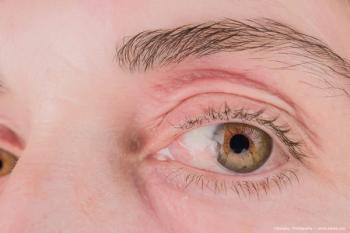
Square-edge design of lens effective against PCO
Washington, DC—The three-piece square-edge design of the Tecnis IOL platform (AMO) seems to protect the eye against development of posterior capsular opacification (PCO) by preventing migration of epithelial cells for at least 3 years after implantation, reported Michael Colvard, MD, FACS, at the annual meeting of the American Society of Cataract and Refractive Surgery.
Washington, DC-The three-piece square-edge design of the Tecnis IOL platform (AMO) seems to protect the eye against development of posterior capsular opacification (PCO) by preventing migration of epithelial cells for at least 3 years after implantation, reported Michael Colvard, MD, FACS, at the annual meeting of the American Society of Cataract and Refractive Surgery.
The Tecnis Edge is a continuous 360° square-edge configuration that has a "barrier effect," uninterrupted by haptic insertion.
In the cases under discussion, Dr. Colvard pointed out that he attempted to make all the anterior capsulotomies central in location and 4 mm in diameter and he used bimanual irrigation/aspiration for cortical cleanup. All the posterior capsules were polished, and the anterior capsules were not.
In this study, 29 patients had the Tecnis three-piece silicone IOL platform implanted between August and December 2001. Dr. Colvard and colleagues conducted a retrospective review of the rates of YAG capsulotomy in patients who had a minimal follow-up of 3 years. A prospective evaluation of the PCO was done using slit-lamp examination and digital retroillumination photography, using the EPCO 2000 analysis system.
Capsular changes demonstrated on retroillumination photos are graded on a scale from 0 to 4 as follows: 0, crystal clear; 1 (minimal), mild wrinkling of the capsule, mild homogeneous layers or sheets of lens epithelium cells; 2 (mild), honeycomb patterns of PCO, thicker homogeneous layers, denser fibrosis; 3 (moderate), classical Elschnig pearls, very thick homogeneous layer; and 4 (severe), very thick Elschnig pearls with a "darkening effect," any type of severe opacification.
No YAG capsulotomies Three-year clinical data were obtained for the 29 patients. Of these, 23 patients were examined 3 years after implantation at the Colvard Eye Center, and six patients, who were not available for examination, were interviewed by telephone. None of the patients had required a YAG posterior capsulotomy.
"To maintain consistency with previous publications, we looked at PCO values for the entire optic and the central 3-mm zone. The averaged PCO values demonstrated virtually no capsular opacification over the area of the entire optic or none whatsoever of the central 3-mm zone," Dr. Colvard explained.
Newsletter
Don’t miss out—get Ophthalmology Times updates on the latest clinical advancements and expert interviews, straight to your inbox.













































.png)


